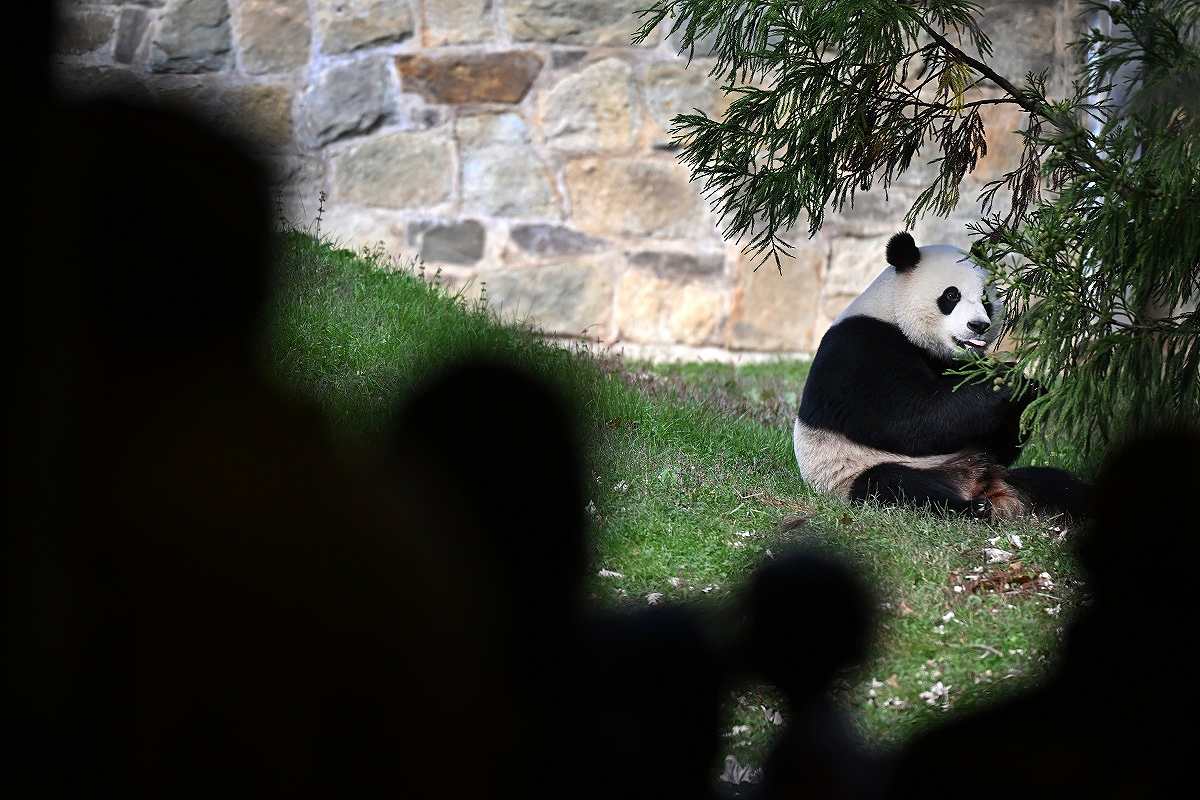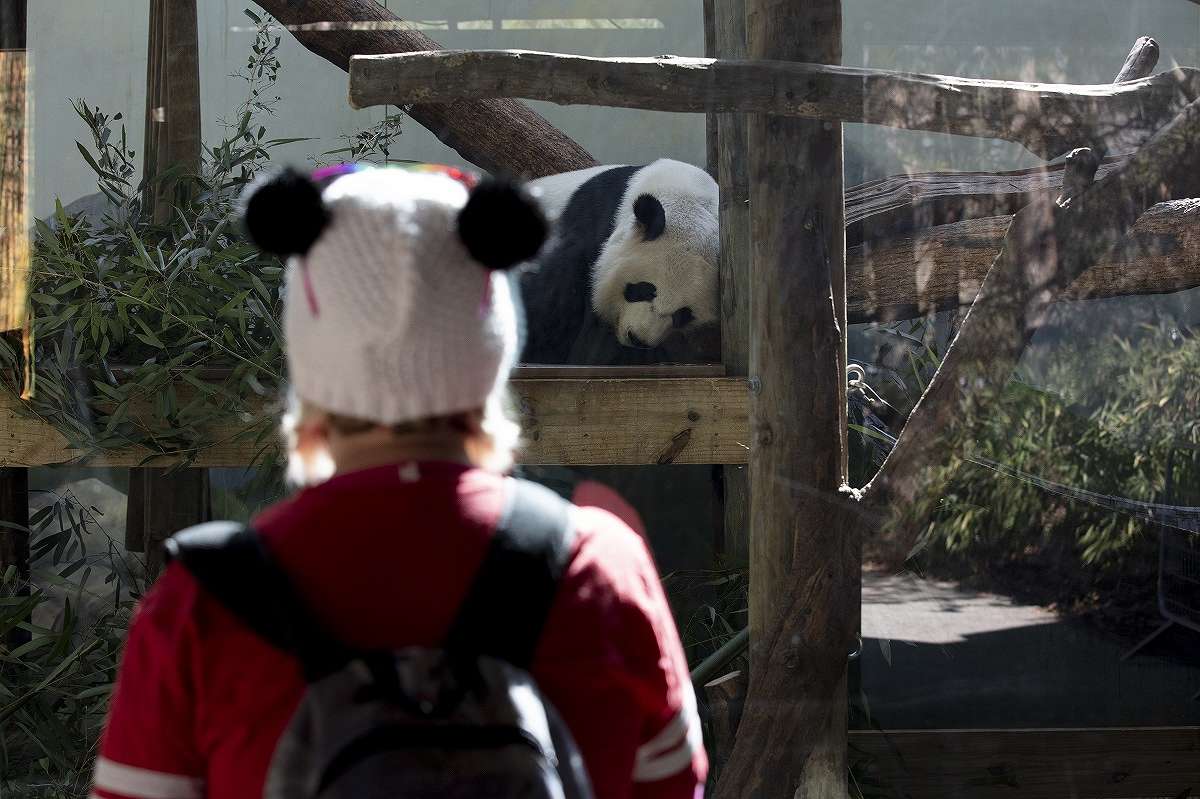
Giant panda Xiao Qi Ji is seen in his enclosure at the National Zoo in Washington before his return to China last year.
14:07 JST, February 24, 2024
As relations between the United States and China have soured in recent years, Beijing has been making its unhappiness known by recalling its softest power: pandas. Three of the black-and-white fluff balls departed the Smithsonian’s National Zoo in Washington last year, triggering a long and tearful farewell. Only one zoo in the country, Atlanta, still had pandas.
But this week came the surprise news that San Diego Zoo has struck a deal to bring giant pandas back to its facility. Then National Zoo officials indicated Thursday that they were “in discussions with our Chinese partner, the China Wildlife Conservation Association, to develop a future giant panda program.”
– – –
What is China saying about this?
The official Xinhua News Agency said Thursday that the China Wildlife Conservation Association has inked agreements with San Diego Zoo Wildlife Alliance and the Madrid Zoo Aquarium of Spain “concerning cooperation on the conservation of giant pandas, as part of efforts to step up the protection of the species on a global level.”
A new round of giant panda conservation collaborative research was about to begin, Xinhua said, focusing on the prevention and control of major diseases for giant pandas and the protection of habitats and wild populations. “These efforts will establish an international academic exchange platform to promote exchanges in the protection of flagship species and umbrella species. They will also promote people-to-people exchanges between China and foreign countries.”
That message was amplified at a Foreign Ministry briefing on Thursday, when spokeswoman Mao Ning said: “We expect the new round of cooperation can further enrich research results on vulnerable species like the giant panda, promote people-to-people exchanges and enhance friendship between people.”
– – –
Is this an about-face? And why?

Jenny Owens, of Wilkesboro, N.C., watches the giant pandas at Zoo Atlanta on Feb. 2. Zoo Atlanta pandas are the only pandas that can be seen in the United States at this time.
Not quite. When Chinese leader Xi Jinping visited San Francisco in November, he suggested Beijing would send new pandas to the United States, calling them “envoys of friendship between the Chinese and American peoples.” Speaking to business executives at a dinner, he said, “We are ready to continue our cooperation with the United States on panda conservation, and do our best to meet the wishes of the Californians so as to deepen the friendly ties between our two peoples.”
The decision to send pandas to San Diego and continue talks with the National Zoo in Washington signals that at least for now, China plans to continue its “panda diplomacy” – the lending of giant pandas to countries around the world as a show of goodwill – despite tensions between the two countries.
After the pandas left the National Zoo in Washington last year, only one giant panda program in the United States remained – at Zoo Atlanta in Georgia. That loan is expected to expire in late 2024. That would have left the United States with no giant pandas for the first time since 1972, when Beijing presented two pandas to President Richard M. Nixon as the two Cold War rivals prepared to normalize ties by the end of the decade. At the time, observers called the recall of the giant pandas “punitive panda diplomacy.”
Last year, Chinese internet users also rallied for the return of the giant panda Ya Ya from the Memphis Zoo following reports of her poor health and the death of another panda at the zoo. Bloggers claimed that Ya Ya, who was returned to China in April, was being mistreated as a result of U.S.-China tensions.
– – –
Are all pandas owned by China?
China, home to the only natural habitat for pandas, has ownership of most of the giant pandas in the world.
Panda diplomacy can trace its roots back to as early as 685 A.D. during the Tang Dynasty, when Empress Wu Zetian presented two pandas as a gift to the Japanese emperor. Between the 1950s and 1980s, China gave the bears as diplomatic gifts to the United States, Russia, North Korea, Japan and other countries.
But in 1984, it began lending pandas on renewable 10-year contracts for between $500,000 and $1 million a year for each panda. Under the terms of the loans, all cubs born abroad belong to China and are to be sent back to China before they turn 4 years old.
About 1,864 pandas live in the wild today, according to the World Wildlife Foundation. According to China’s National Forestry and Grassland Administration, 56 pandas were on loan to other countries in 2023. China has gifted four pandas to Hong Kong, a special administrative region under China’s jurisdiction. In 2008, it gave two pandas to Taiwan, which Beijing considers part of China.
Giant pandas, now classified as vulnerable rather than endangered as a result of protection efforts, once roamed Myanmar and northern Vietnam as well as southern and eastern parts of China. Today, they live only in the mountains of southwestern China.
– – –
What does China get out of panda diplomacy?
For decades, the bears have served as goodwill ambassadors that soften China’s image abroad, where China has been criticized for human rights abuses and its increasingly authoritarian system.
No leader knows how much pandas symbolize enduring friendship with Beijing more than Russian President Vladimir Putin. China gave Russia two pandas in April 2019 on an unusually extended 15-year loan. Later, during a visit to see them at the Moscow Zoo in June, Xi referred to Putin as his “best friend.”
Two pandas arrived in Malaysia in May 2014, less than two months after a Malaysia Airlines flight carrying more than 200 people disappeared between Kuala Lumpur and Beijing, which had boosted tensions and spurred campaigns of boycotts and protests by citizens of both countries. The pandas, however, became instant celebrities.
As for the new round of panda diplomacy with the United States, experts said the pandas are meant to add to the “positive elements” of the U.S.-China relationship during a difficult time.
Beijing “hopes this will provide more impetus for a better China-U.S. relationship,” said Shen Yamei, director of American Studies at the China Institute of International Studies, a think tank under China’s Foreign Ministry. “They want to continue the kind of cooperation … where we can sit down and talk and reach some kind of consensus.”
"News Services" POPULAR ARTICLE
-

American Playwright Jeremy O. Harris Arrested in Japan on Alleged Drug Smuggling
-

Taiwan President Shows Support for Japan in China Dispute with Sushi Lunch
-

Japan’s Nikkei Stock Average as JGB Yields, Yen Rise on Rate-Hike Bets
-

Japan’s Nikkei Stock Average Licks Wounds after Selloff Sparked by BOJ Hike Bets (UPDATE 1)
-

Japanese Bond Yields Zoom, Stocks Slide as Rate Hike Looms
JN ACCESS RANKING
-

Keidanren Chairman Yoshinobu Tsutsui Visits Kashiwazaki-Kariwa Nuclear Power Plant; Inspects New Emergency Safety System
-

Japan to Charge Foreigners More for Residence Permits, Looking to Align with Western Countries
-

Imports of Rare Earths from China Facing Delays, May Be Caused by Deterioration of Japan-China Relations
-

Japan Exports Rise in October as Slump in U.S. Sales Eases
-

Govt Aims to Expand NISA Program Lineup, Abolish Age Restriction

























